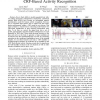Free Online Productivity Tools
i2Speak
i2Symbol
i2OCR
iTex2Img
iWeb2Print
iWeb2Shot
i2Type
iPdf2Split
iPdf2Merge
i2Bopomofo
i2Arabic
i2Style
i2Image
i2PDF
iLatex2Rtf
Sci2ools
112
Voted
ICPR
2010
IEEE
2010
IEEE
Motif Discovery and Feature Selection for CRF-Based Activity Recognition
Abstract—Due to their ability to model sequential data without making unnecessary independence assumptions, conditional random fields (CRFs) have become an increasingly popular discriminative model for human activity recognition. However, how to represent signal sensor data to achieve the best classification performance within a CRF model is not obvious. This paper presents a framework for extracting motif features for CRF-based classification of IMU (inertial measurement unit) data. To do this, we convert the signal data into a set of motifs, approximately repeated symbolic subsequences, for each dimension of IMU data. These motifs leverage structure in the data and serve as the basis to generate a large candidate set of features from the multi-dimensional raw data. By measuring reductions in the conditional log-likelihood error of the training samples, we can select features and train a CRF classifier to recognize human activities. An evaluation of our classifier on the CMU Mu...
Computer Vision | Conditional Random fields | ICPR 2010 | Popular Discriminative Model | Signal Sensor Data |
| Added | 03 Jul 2010 |
| Updated | 03 Jul 2010 |
| Type | Conference |
| Year | 2010 |
| Where | ICPR |
| Authors | Liyue Zhao, Xi Wang, Gita Sukthankar |
Comments (0)

